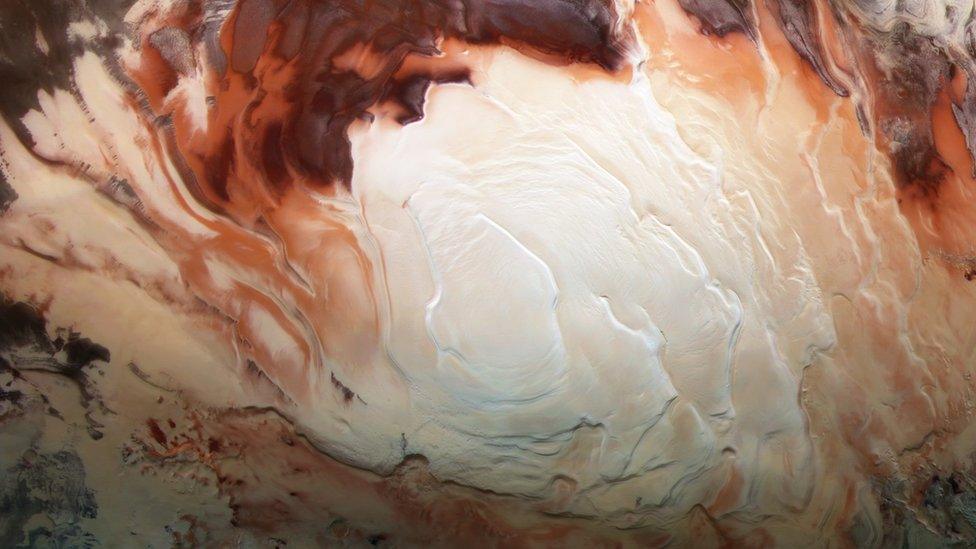Buried lakes of liquid water discovered on Mars
- Published

The findings come from data collected by Esa's Mars Express spacecraft
Three new underground lakes have been detected near the south pole of Mars.
Scientists also confirmed the existence of a fourth lake - the presence of which was hinted at in 2018.
Liquid water is vital for biology, so the finding will be of interest to researchers studying the potential for life elsewhere in the Solar System.
But the lakes are also thought to be extremely salty, which could pose challenges to the survival of any microbial life forms.
Billions of years ago, water flowed in rivers and pooled in lakes on the Martian surface. But Mars has since lost much of its atmosphere, which means water can't stay liquid for long on the surface today.
However, it's a different matter underground.
Referring to the sub-surface lakes, co-author Dr Roberto Orosei, from Italy's National Institute of Astrophysics in Bologna, told BBC News: "It's even more likely that these bodies of water existed in the past.
"Of course, the implication of this is that you would have a habitat or something that resembles a habitat... that lasted throughout the history of the planet,"
"As Mars was undergoing its climatic catastrophe and turning from a relatively warm planet - though it's not clear how warm - to a frozen waste, there was a place where life could adapt and survive."
The latest discovery was made using data from a radar instrument on the European Space Agency's (Esa) Mars Express spacecraft, which has been orbiting the Red Planet since December 2003.

The main lake (centre) is surrounded by at least three smaller bodies of water
In 2018, researchers used data from the Marsis radar to report signs of a 20km-wide subsurface lake located 1.5km under Mars' south polar layered deposits, a thick polar cap formed by layers of ice and dust.
However, that finding was based on 29 observations collected by Marsis between 2012 and 2015. Now, a team including many of the same scientists from the 2018 study have analysed a much bigger dataset of 134 radar profiles gathered between 2010 and 2019.
"Not only did we confirm the position, extent and strength of the reflector from our 2018 study, but we found three new bright areas," said co-author Elena Pettinelli from Roma Tre University in Italy.
"The main lake is surrounded by smaller bodies of liquid water, but because of the technical characteristics of the radar, and of its distance from the Martian surface, we cannot conclusively determine whether they are interconnected."
'Extended pools'
The team borrowed a technique commonly used in radar sounder investigations of sub-glacial lakes in Antarctica, Canada and Greenland, adapting the method to analyse the data from Marsis.
"The interpretation that best reconciles all the available evidence is that the high intensity reflections (from Mars) are coming from extended pools of liquid water," said co-author Sebastian Lauro, also from Roma Tre University.
There's not enough heat at these depths to melt the ice, so scientists believe the liquid water must contain high concentrations of dissolved salts. These chemical salts (different to the stuff we sprinkle on our chips) can significantly lower water's freezing point.
In fact, recent experiments have shown, external that water with dissolved salts of magnesium and calcium perchlorate (a chemical compound containing chlorine bound to four oxygens) can remain liquid at temperatures of -123C.

The proposed bodies of liquid water were discovered under the south polar cap of Mars
"These experiments have demonstrated that brines can persist for geologically significant periods of time even at the temperatures typical of the Martian polar regions (considerably below the freezing temperature of pure water)," said co-author Graziella Caprarelli, from the University of Southern Queensland, Australia.
Some hypersaline lakes on Earth can reach salt concentrations of 40%. Just how saline the lakes are on Mars isn't something that's known precisely.
"This is a difficult question to answer," Dr Orosei, who is the principal investigator on the Marsis experiment, told me. "We do not know the thermodynamical conditions down there and we do not know the kinds of salts that are dissolved in the water if they are down there.
"We expect that water would be close to the saturation point (the stage at which no more salt can be dissolved), because as water stands there, it leaches through rocks and tends to dissolve every salt it meets... we're talking about several tens of percent [of salt content in the lakes]."

Mars is a freezing desert today, but billions of years ago, water flowed on the surface
The lakes' salinity is of particular relevance to the life question. Terrestrial microbes that thrive in very salty conditions are known as halophiles. But studies have shown that bugs can tolerate more extreme salinities when temperatures are higher, and colder temperatures when salinity is lower.
The range of conditions micro-organisms can withstand is more limited when environments are both very saline and very cold, because of a double whammy effect.
There is ongoing research into whether life could survive in conditions like those in the lakes on Mars. Dr Orosei said: "Salt in very high concentrations is not very friendly to life." Life, he added, "is still a possibility, but there's much more work to do".
There had been criticisms of the 2018 paper, with some researchers proposing that the main lake could be the result of an exceptional situation, such as the presence of a volcano under the polar cap heating ice from below.
"By finding more of these bodies of water, this means it's something different - it's not a unique phenomenon, it's not a unicorn. It's something that must be occurring rather naturally," said Dr Orosei.
He said the fact such lakes could have persisted for much of Martian history meant "they could still retain traces of any life forms that could have evolved when Mars had a dense atmosphere, a milder climate and the presence of liquid water on the surface, similar to the early Earth".
The team isn't finished yet, however, and plans to keep gathering data "as long as Mars Express lasts", according to Roberto Orosei.
The findings have been published in the journal Nature Astronomy., external
Follow Paul on Twitter., external